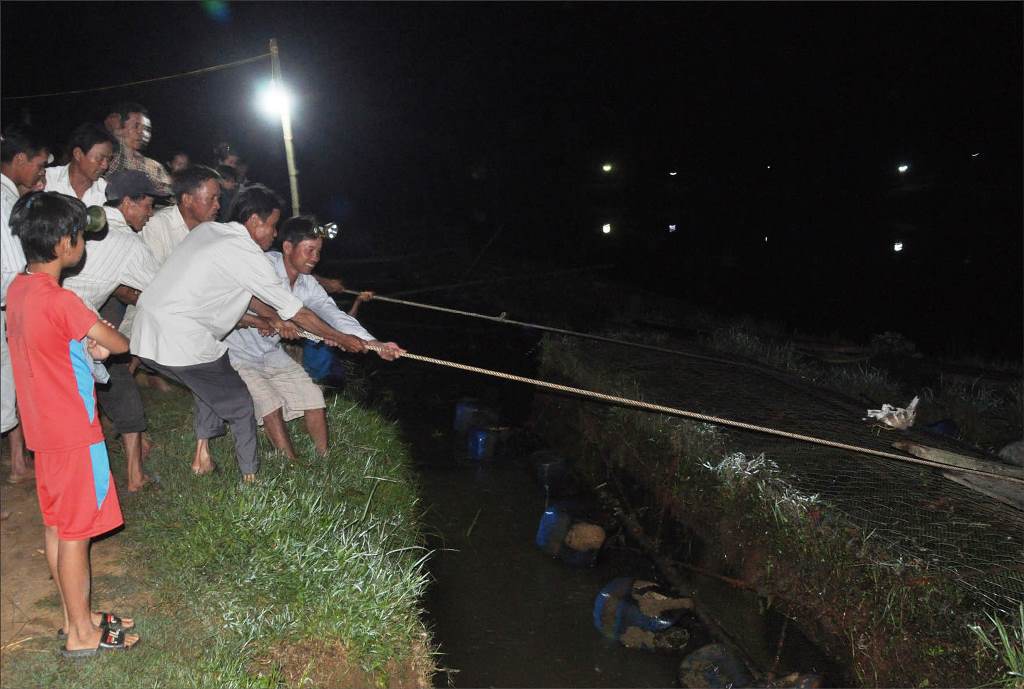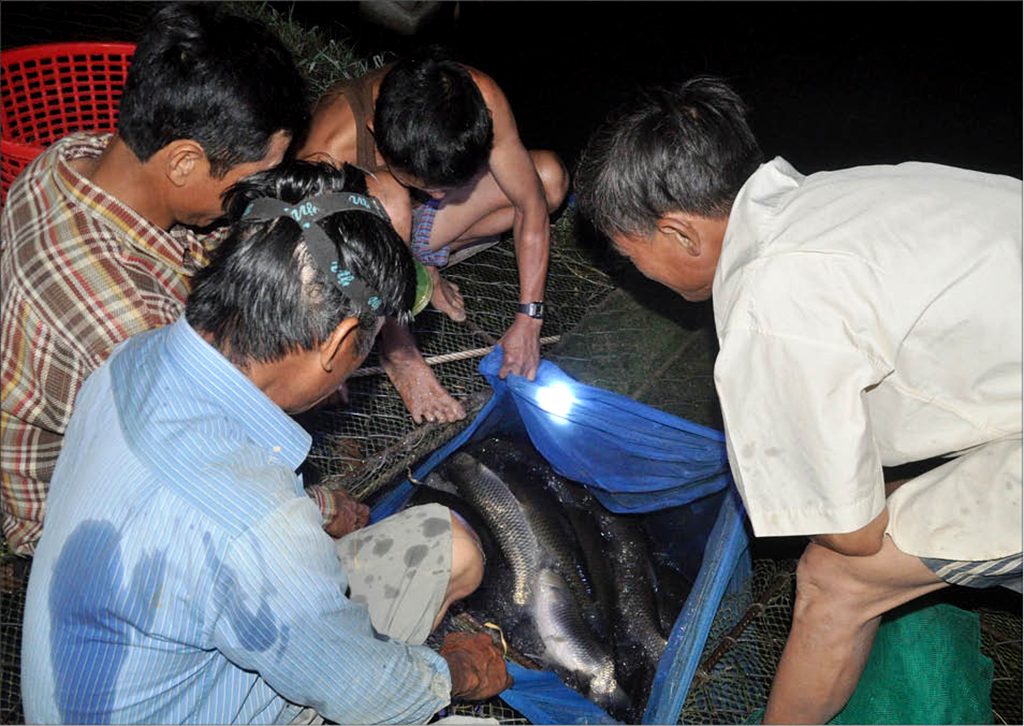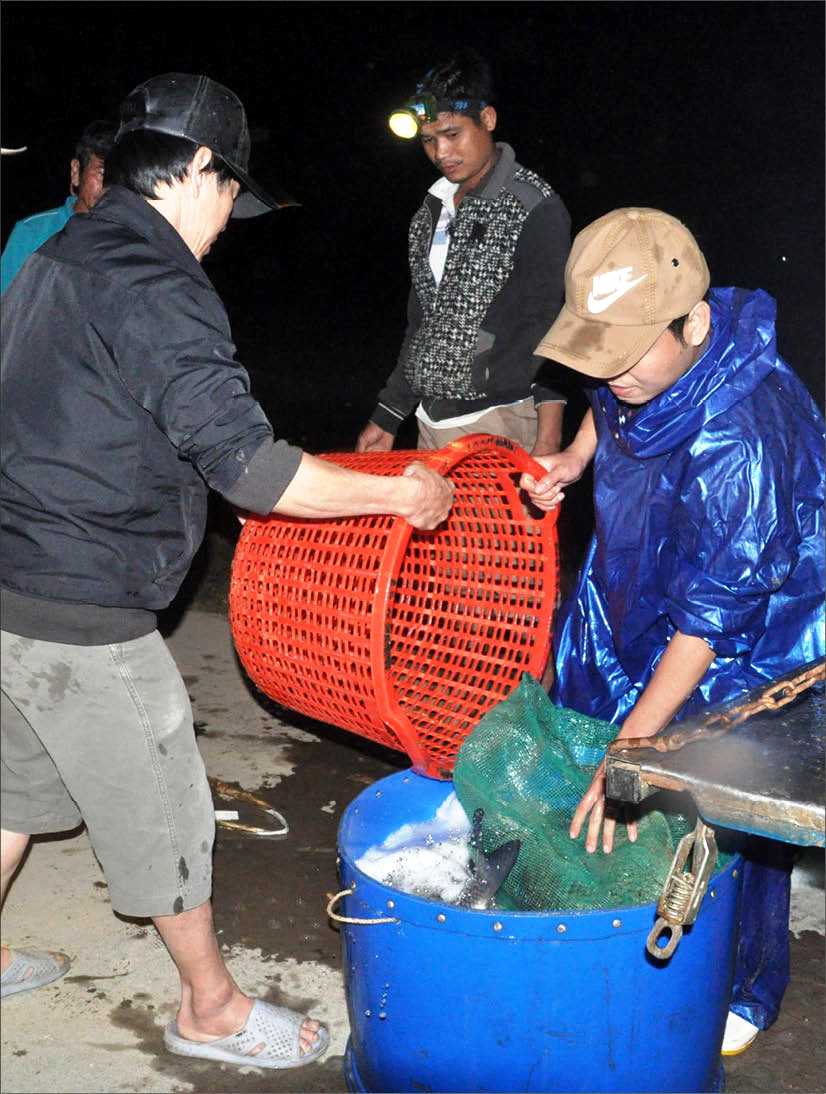
Co Lao farmers are helping each other harvest fish at night
Survivors of the flooding
The call from Mr. Nguyen Van Lai, Director of Tay Toan Agricultural Cooperative (Huong Tra district) urged me to come with him to a fish harvest in the middle of the night. At 9pm, as I took my backpack to rush to the river, the Bo river was still mysteriously calm and quiet!
"I almost missed the fish harvest,” the cooperative director frowned. “I’ve been waiting the whole month for the harvest. Only two breeders harvest tonight.” Hardly had we reached the bank when I realized I was completely wrong about the river’s seclusion. Indeed, harvesting fish from the Bo river excited the entire Co Lao village.
Since the afternoon, the old and the young, men and women alike sipped hot green tea while predicting the fish price and weight. Both banks of the river were then brightly lit up as the eyes of the breeders seemingly glowed in hope for a desirable outcome after one and a half year rearing the fish cages.

The first batch of fish from the cage
The breeding season of grass carp normally starts every February and March. Small-size fingerlings take 1.5 years to reach marketable sizes while bigger fries take only a year to harvest.
Mr. Lai said: “The two biggest worries when nursing carps for a longer season are... the hydropower and flood. Surviving these two, the season surely yields hefty profit for the farmers. That’s why they breed large-size fingerlings to be timely ready for the Tet holidays. Survivors of successive flooding like these cages are exceptionally rare, and thus, undoubtedly lucrative.”
Of more than 90% of cage fishing farmers in Co Lao village, only a few raised fish in cages off season. Therefore, fish farmers like Mr. Pham Van Thien knew the hydropower regulation schedule like the back of his hand and prepared a wise irrigation plan to mitigate drought and saltwater intrusion.
According to Mr. Thien, after sequential floods and droughts, most of his fish had been harvested. His few remaining carp cages raised for nearly one and a half year now awaited sale. On average, each cage of 30m2 stocked about 200-300 fries, yielding around a tonne of commercial fish and can be sold for roughly 60 million VND. Off season fish breeding is often more lucrative, and when excluding expenses, the profit may reach 50 million VND.
As if he wanted to explain more, Mr. Thien said, 50 million VND was adequate for a saving, in case the main season suffered from failure. But if the main season were successful, it can be an enormous boon to the breeders’ profit. Also, farming in the off-season is profitable because despite the long nursing time, the cost is conversely low. Farmers used vegetables, banana stems, and only some commercial feeds as supplemental diet, so the fish meat is very firm and fresh.
Generous farmers
A fish cage owner, Le Van Muc (Giap Kieng village), rolled up his sleeves while crying aloud: “Give me a hand.” From the sides of the dyke, young men stood up from the sitting pads, rolled up pant legs and dashed to the river. Each time of harvesting fish cages, at least ten people showed up to help.
These people are also owners of fish cages along the same river. Some anchored to pull up the cage; some laid down temporary wooden dock to transfer the fish; others used wheelbarrows to transport the fish to the main roads for traders.
Only the owner would catch the fish in the cage himself, not because it was a hard task, but a long-established tradition. After all this time and effort, it was the owner who most longed for holding the outcome with his bare hands after one and a half year’s time rearing the fish,” Mr. Muc said.
The loud cries stirred up the silence at night as the men urged to lift the first fish cage from the river to the edge of its bank. The moment the first batch of fish was pulled out of water, we sensed the joy in the cage owner’s eyes as the carp weighed from 4-5 kg/each.
“How did you get to know their mass?” I asked, followed by Mr. Muc’s reply “I have raised carps now for 10 years. I know which sides of the river is shallow or deep, let alone the fish I have carefully nurtured in the cages. The first 10 fish could fill a wheelbarrow, and that’s a good sign!”
Because traders could not get down to the river bank, fish farmers had to use wheelbarrows to transport the fish onto the main road. Each fish cage filled a few dozens of such wheelbarrows. The hustle and bustle of helpers along the river did not end until all fish in the cage were caught.
I was curious to see that many labors coming to help at the fish harvest, and thought the owner must have hired extra workers. Yet Mr. Nguyen Van Lai, Director of Tay Toan Cooperative laughed and admitted frankly, "That was just the farmers’ generosity, and we helped each other.”
He went on to point at the maize field along the bank and revealed, "Farmers would do their own cultivation, but we volunteered to help one another every harvest season on the river.” At the end of the day, the "reward" might be a pack of beer cans from the cage owner, and that’s enough for a feast.”
A model of sustainable farming
Mr. Hoang Trong Hieu, Chairman of Huong Toan People's Committee released an impressive figure: The whole commune had 844 grass carp cages with 369 farming households and annual yields of 418 tonnes. Only a third of these surveyed cages survived the flooding and eventually brought about high economic value for the owners.

Transporting the fish to dealers
After the failure of the main season due to bad weather, off-season fish farming on the Bo river promised a better return for the breeders to continue further investment. They put faith in the river and nurtured their dream of having a sustainable cage farming model.
According to the Provincial Aquaculture unit, the number of fish cages and rafts in the area has reached nearly 6,000 in total (129,780m3), with more than 3,000 households involved. Currently, cage culture in localities has developed thanks to the high economic efficiency, as locals have made use of the surface water of lagoons, rivers, hydropower reservoirs as well as of home-made food sources and agricultural waste.
Story and photos: Ha Nguyen